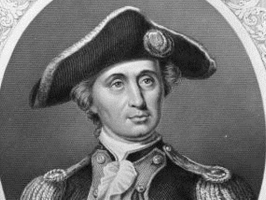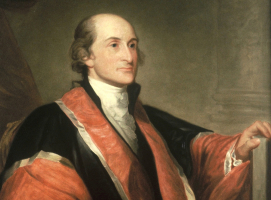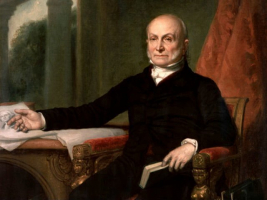Top 8 Interesting Facts about John Philip Sousa
The "March King" and American military march composer John Philip Sousa left behind an incredible body of work that is still played today. His impact on ... read more...American music history as a composer and conductor throughout the Romantic era is unmatched. Check out these interesting facts about John Philip Sousa, “the man behind the marches”!
-
Sousa studied the piano and other instruments while still a teen, and he excelled at the violin. John was highly talented on the violin, which was the first instrument he learned when he began taking lessons at the age of 10, and the piano.
At the age of 13, due to his passion for music, he came close to joining the circus band, which would have required him to travel and provide the music for the performances. Fortunately, though, his father intervened and stopped what would have been a waste of his abilities. He was hired as an apprentice musician in the Marine Band when his father intervened. This is one of the interesting facts about John Philip Sousa.
Sousa remained a member of the band until he was 20 years old, with the exception of a six-month hiatus. Before being asked to lead the Marine Band at age 25, he went on tour with various bands. When he was the conductor, the band developed a stellar reputation.
Photo: www.marineband.marines.mil 
Photo: www.thefamouspeople.com -
Antonio Sousa, the father of John Philip Sousa, played the trombone in the US Marine Band. This is a fascinating fact about John Philip Sousa that explains why he decided to enlist his son in the band. In addition, young Sousa was born in Washington and grew up nearby the Marine Barracks. It was all part of his early life.
When he first started learning music, John Esputa Sr. taught him solfeggio. However, because of the teacher's propensity for losing his temper, this was only fleeting. As a student of John Esputa Jr., the father of his former instructor, under whom Sousa studied the violin, piano, flute, many brass instruments, and singing, his serious musical education began in 1861 or 1862. Esputa had a temper like his father, and the teacher-student bond was frequently strained, but Sousa advanced very quickly and was also discovered to have an excellent pitch. During this time, he created his first work, "An Album Leaf," which Esputa rejected as "bread and cheese" and which was later destroyed.
In 1868, his father enlisted him as an apprentice in the US Marine Band. In the five years after quitting the band in 1875, he played the violin and honed his conducting skills. After re-joining the Marine Band in 1880 and serving there as director for 12 years, David Blakely, P.S. Gilmore's old agent, engaged him to lead a band. Blakely wished to rival Gilmore. He dedicated himself entirely to conducting and writing music from 1880 till his death. The sousaphone, a huge brass instrument akin to the helicon and tuba, was created with Sousa's help.
Photo: sousamusic.com Video: Taps Bugler -
Sousa remained in Washington for a while after being released from the Marine Corps, directing and playing the violin. He traveled with a number of traveling theater orchestras before relocating to Philadelphia in 1876. He was employed by publishing businesses there as a composer, arranger, and proofreader. Sousa was enthralled by the operetta genre and went on tour with a group performing the musical Our Flirtation, for which he composed the march and the accompanying music. He received a telegram offering him the direction of the Marine Band in Washington while on tour in St. Louis. On October 1st, 1880, he accepted and reported for duty, becoming the band's 17th Leader.
Sousa's first experience leading a military band was the Marine Band, and he addressed musical things differently than most of his predecessors. In order to suit his demands, he substituted symphonic transcriptions for a large portion of the library's musical selections. He molded his musicians into the nation's best military band, and practices became incredibly rigid. Concerts by the Marine Band started to draw discerning crowds, and word of the band traveled quickly.
When Sousa composed "The Gladiator" in 1886, military band circles began to recognize him. He started getting more and more respect and attention as a composer after that. He composed "Semper Fidelis" in 1888. It is regarded as the "official" march of the Marine Corps and is dedicated to "the officers and men of the Marine Corps."
Photo: flickr.com Video: United States Marine Band -
Sousa was in charge of the band, which the Columbia Phonograph Company chose to record utilizing the new technology. Over 400 of Sousa's compositions were available for the phonograph by the end of the 19th century, with the first recordings appearing in 1890. As a result, John Philip Sousa's music gained enormous popularity, and the Marine Band went on to become one of the first international recording stars.
The Marine Band was one of the first international recording stars as a result of this. He wrote 136 outstanding military marches during this time, including "El Captain," "Washington Post," "Semper Fidelis," "Liberty Bell," and "The Daughters of Texas," among many others, with his most well-known work being "Stars and Stripes Forever" in 1897.
Promoter David Blakely persuaded Sousa to leave the Marine Band following two successful but constrained tours in 1891 and 1892. As a result, Sousa's New Marine Band was formed.
The band's debut performance was placed at Plainfield, New Jersey's Stillman Music Hall on September 26, 1892. Patrick Gilmore, the band's leader, had passed away in St. Louis two days previously. Eventually, 19 of Gilmore's former musicians, including Herbert L. Clarke (cornet) and E. A. Lefebre, joined Sousa's band (saxophone). Despite being known as Sousa's New Marine Band, the group finally changed its name after facing backlash from Washington.
Photo: www.wbur.org 
Photo: commons.wikimedia.org -
Before Sousa, the Marine Band didn't go on tour. In 1891, he convinced President Benjamin Harrison to approve the Marine Band's first-ever concert trip, which launched the custom of a yearly tour. Since then, with the exception of times of war, the tour has been held annually. President Benjamin Harrison approved Sousa's plan for the Marine Bands' inaugural marching band tour, which began the Marine band's annual tour tradition. The journey continued over the years with the exception of the world war.
Sousa conducted his own band in concerts despite having been released from active duty and wearing his Navy uniform. Additionally, he would wear it for appearances in public. Although he was promoted to lieutenant captain in the Naval Reserve, he never returned to active duty. For his military service, he was also awarded the World War I Victory Medal and was made a Veteran Companion of the Military Order of Foreign Wars. The American Legion was where he belonged.
Photo: www.discoverwalks.com 
Photo: sousamusic.com -
The Notable Achievements of Sousa In addition, Sousa composed the now-famous "Washington Post March" (1889), which was a tremendous success in both North America and Europe and gave him the moniker "The March King." The Marine Band began recording for the newly created phonograph at this time.
American composer and conductor John Philip Sousa (/su/; November 6, 1854 – March 6, 1932) is best known for his American military marches. To distinguish him from his British counterpart, Kenneth J. Alford, he is referred to as "The March King" or the "American March King."
As commissioned by the Washington Post newspaper, Sousa originally composed the march "The Washington Post" in 1889 to promote an essay competition for that publication. It became extremely popular and became known as the two-step dance. A well-known British journalist dubbed Sousa "The March King" as a result of this attention.
Written in 1889, the march "The Washington Post" quickly gained enormous popularity. It was initially created to promote an essay competition for the Washington Post newspaper. However, it was so well-liked that the two-step, a dance, was created from it.
Photo: Pinterest Video: Public Domain Classical Music -
John Sousa joined the Naval Reserve after the United States started the First World War in 1917 by declaring war on Germany. He was 62 years old, which was the navy officer retirement age. Up until his discharge in November 1918, he remained on active duty. After being released from the Navy, he kept wearing his uniform and wore it while leading his band in performances and other public engagements.
Sousa was commissioned as a lieutenant in the Naval Reserve in 1917 after the US had declared war on Germany. He was already 62 years old at the time and had reached the obligatory retirement age for navy officers.
The interesting facts about John Philip Sousa are that he led the Navy Band in the Great Lakes Naval Station, close to Chicago, and actively participated in the war effort. He even went so far as to contribute all but $1 of his monthly Navy salary to the Sailors' and Marines' Relief Fund. He served until November 1918, at which point he was released and left to start his own band.
Photo: www.dallassymphony.org 
Photo: Wikipedia -
Sousa received a great deal of acclaim for his contributions and popularity both during his lifetime and after. An interesting fact about John Philip Sousa is that because of his global fame, he was awarded the Royal Victorian Medal and the Portuguese Order of Public Instruction, the latter of which was given to him by King Edward VII of the United Kingdom in recognition of his conducting of a private birthday concert for Queen Alexandra. He was given the name John Philip Sousa in honor of the World War II Liberty Ship, and in 1976, he was inducted posthumously into the Hall of Fame for Great Americans.
Sousa was a renowned musician and patriot who was also well-known both before and after his death in 1932. He received numerous honors and varied tributes, including the dedication of the Pennsylvania Avenue bridge in Washington, DC, over the Anacostia River in December 1939; the renaming of the Marine Band's barracks in 1974 to the John Philip Sousa Band Hall; his inclusion in the Hall of Fame for Great Americans in 1976; and the 1987 adoption of The Stars and Stripes Forever as the National Anthem of the United States.
To commemorate John Sousa's 150th birthday, the new band hall at the marine barracks annex was named after him in 2004 by General Michael Hagee, 33rd Commandant of the Marine Corps. In November 2005, he unveiled an 8-foot-tall bronze statue of Sousa outside the band hall.
Photo: /www.wikidata.org Video: Fledermaus1990





























